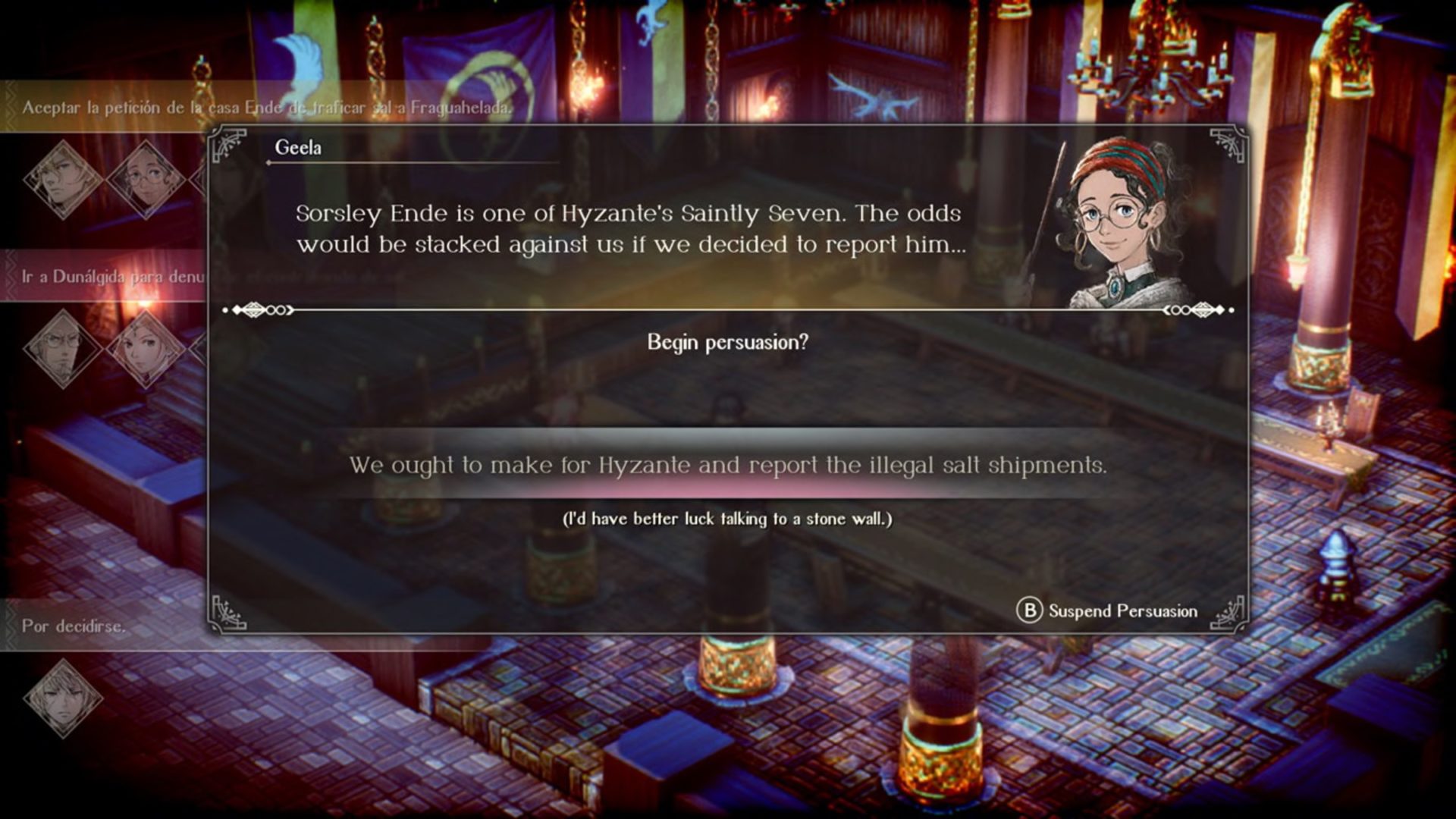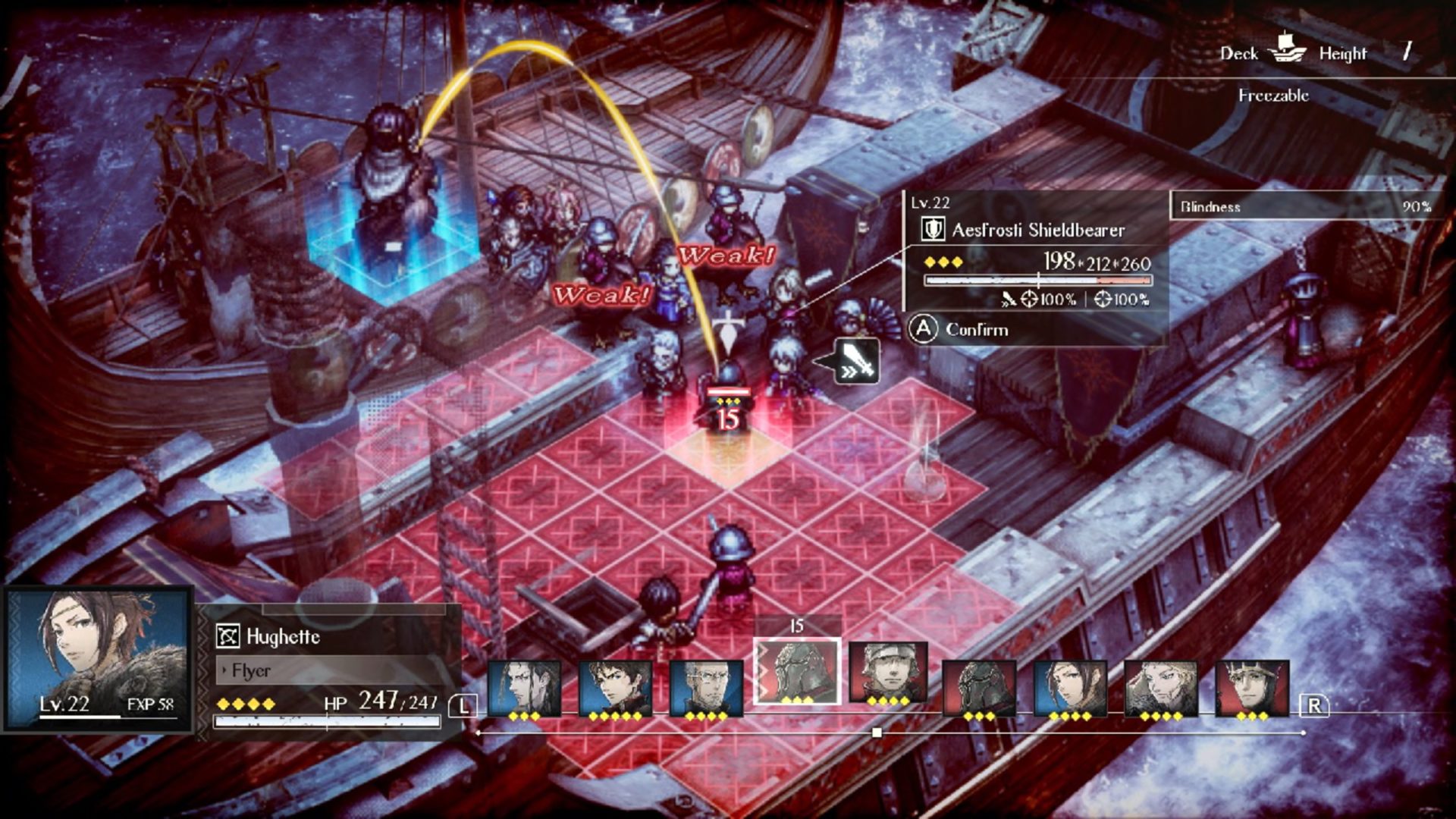They have a fight; Triangle wins.
I’ve recently completed the second demo for Square Enix’s forthcoming TRPG Triangle Strategy, and I have thoughts—specifically, 11 of them in neatly organized bullet-point format. If that’s too many, to read through, just know this; if you tried the first Triangle Strategy demo and didn’t get into it, you’ll want to make sure you give it another try ahead of its March 4th release.
Why? Well…
- Because your progress will carry over into the new game, we this time start at the beginning of the story. This obviously does a much better job of introducing the narrative, the characters, and—more importantly—the battle system. As such, you’ll get what the game is doing.
- I’m still not fully into the retro-modern HD-2D visual presentation. Certain aspects look great (I love the lighting and bluffing effects), but the jagged characters and background elements are too jagged for my tastes. I’d like to see Square Enix provide just a bit more detail. The graphics are by no means a deal breaker, I just don’t see them as a selling point.
- The story, on the other hand, surely will be a selling point. It begins with an arranged marriage for political purposes, but it’s handled in a practical manner. Both participants understand why it’s important, and they quickly grow to like/respect each other, but they also realize the reason they were chosen may not bode well for them or their countries. That draws them together, for now, but you can easily see how this whole setup can blow up on many levels, and your decisions will likely impact that.
- Those decisions are handled in a clever way. The demo provides only one; after a gathering of the nations’ leaders, you must decide with which leader you’ll return as a special envoy. Your decision will curry favor with the nation you pick, but slight the other. In the path I chose, I ended up getting a new companion from that nation. I’m assuming that would’ve happened if I’d chosen the other path, so I’m curious if that route would’ve given me someone with completely different abilities.
- Anyway, back to the clever mechanic for decisions. Your party gets to make those decisions for you! There’s a scale (physical, not metaphorical), and each party member gets to cast a vote to tip it one way or the other. If you have a particular path you’d like to take, it’s up to you to persuade them to vote your way.
- The ability to do so will depend upon how many dialogue options you’ve unlocked. Talking to NPCs will reveal information that could be important in these decisions, allowing those details to be presented with your arguments. If you’re not sure what to do, pay attention to your party members. In the one decision I faced in the demo, I just went with what my fiancée wanted because it seemed really important to her. Maybe now she’ll agree to let me spend $1,300 to restore my Flash Gordon pinball machine.
- Of course, all of these characters and plot elements mean there’s going to be a lot of story to read. The demo is decided heavily on story. The battles are few and somewhat short. That’ll change, I’m sure, but prepare yourself for a lot of reading and meandering.
- Curiously, it looks like you don’t have to read anything. A world map between fights/story allows you to see where events are. Red events are required to move the story. Green events are optional. In the demo, all green events simply told me what was going on elsewhere in the kingdom with other characters. It all seemed important, however, so I’m not sure why it would’ve been considered optional or if these segments would’ve disappeared if I pushed too far ahead.
- When you do get to combat, it’s quite fun. As you’ve surely seen, it’s turn-based on an isometric grid. Positioning for the high ground or attacking from behind your opponent is very important, but doing so can leave your party members hung out to dry. Getting the high ground for my archer, for example, is great for attacks, but that often left her within range of the enemy.
- You can address items like this with equipment and buffs, but that’s all part of the strategy. Do I want to give my archer better defense so she can withstand an extra attack or two, or do I want to jack up the defense on my tank since that’s how he’ll be used on nearly every turn? You know the routine.
- Environment is important, too, and you can affect that. For example, an enemy may cast an ice spell that freezes the ground beneath your warriors, slowing them down and making them more likely to miss. You can eliminate this condition by casting a fire spell to melt the ice, but that creates a puddle. Now, if your enemy has an electric spell, they’ll do extra damage to all of those standing in the puddle.
The Triangle Strategy demo takes only a few hours to play through, but that’s enough to let you know what to expect from this highly anticipated game. You’ll get deep, strategic battles and an expansive, intricate story. I can see how both gameplay and plot could possibly become burdensome, but we’ll see if Square Enix is able to keep things tightly integrated and well-paced. They didn’t quite do so with the somewhat similar Octopath Traveler, but this second Triangle Strategy demo has me feeling optimistic.
Triangle Strategy will be available for Switch on March 4th. For more information visit the Nintendo eShop.





February 18, 2022
[…] post Triangle Strategy bullet point preview appeared first on Pure […]
February 18, 2022
[…] Triangle Technique (Swap demo) – I used to be hyped about this new demo after the latest Nintendo Direct. This quick intro to the sport brings us three chapters, some attention-grabbing backstory, and an honest battle expertise. […]
February 21, 2022
[…] Triangle Strategy (Switch demo) – I was hyped about this new demo after the recent Nintendo Direct. This short intro to the game brings us three chapters, some interesting backstory, and a decent battle experience. […]